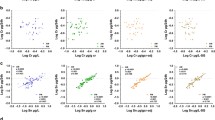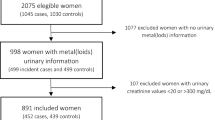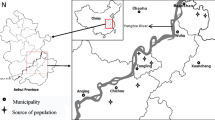Abstract
Human exposure to elements is a process difficult to control and monitor. Studies on this topic usually rely on single spot urine sample to assess exposure, with the risk of ignoring variability over a longer period. In this work, we measured the urinary excretion of toxic and essential elements during 1 year with the overall goal of exploring the variability caused by seasonality on their concentration. Seven participants were recruited, and first morning urines were collected three times for each season, during November, January, April and July. Participants followed the same balanced diet during the week of collection. We then monitored nineteen essential and toxic elements in urines by inductively coupled plasma mass spectrometry. Unsupervised multivariate statistical analysis separated samples collected during summer from the ones collected during other seasons. Twelve elements had a significant seasonal variation (ANOVA test, p < 0.05) and their levels resulted increased during summer. These elements were both contaminants, such as Ni, Hg, Cd and Tl, and essential elements such as Se and Cu. However, none of these elements was detected at toxic concentration. In this study, we point out for the first time the variability of urine element concentration due to seasonality and we propose that the season of collection should be considered when providing urinary reference values of elements.





Similar content being viewed by others
References
Alessio L (1993) Reference values for the study of low doses of metals. Int Arch Occup Environ Health 65:S23–S27
Birgisdottir BE et al (2013) Essential and toxic element concentrations in blood and urine and their associations with diet: results from a Norwegian population study including high-consumers of seafood and game. Sci Total Environ 463–464:836–844. doi:10.1016/j.scitotenv.2013.06.078
Daher N, Hasheminassaba S, Shafer MM, Schauer JJ, Sioutas C (2013) Seasonal and spatial variability in chemical composition and mass closure of ambient ultrafine particles in the megacity of Los Angeles. Environ Sci Process Impacts 15:283–295
Fréry N, Saoudi A, Garnier R, Zeghnoun A, Falq G (2011) Exposition de la population française aux substances chimiques de l’environnement. Institut de veille sanitaire, Saint-Maurice, p 151
Friberg L, Nordberg GF, Vouk VS (1986) Handbook on the toxicology of metals. Elsevier, New York
Gunier RB et al (2013) Determinants and within-person variability of urinary cadmium concentrations among women in northern California. Environ Health Perspect 121:643–649. doi:10.1289/ehp.1205524
Hao Z, Li Y, Li H, Wei B, Liao X, Liang T, Yu J (2015) Levels of rare earth elements, heavy metals and uranium in a population living in Baiyun Obo, Inner Mongolia, China: a pilot study. Chemosphere 128:161–170. doi:10.1016/j.chemosphere.2015.01.057
Heitland P, Koster HD (2004) Fast, simple and reliable routine determination of 23 elements in urine by ICP-MS. J Anal At Spectrom 19:1552–1558
Heitland P, Koster HD (2006) Biomonitoring of 30 trace elements in urine of children and adults by ICP-MS. Clin Chim Acta 365:310–318. doi:10.1016/j.cca.2005.09.013
Hoet P, Jacquerye C, Deumer G, Lison D, Haufroid V (2013) Reference values and upper reference limits for 26 trace elements in the urine of adults living in Belgium. Clin Chem Lab Med 51:839–849. doi:10.1515/cclm-2012-0688
Kumagai Y, Arimoto T, Shinyashiki M, Shimojo N, Nakai Y, Yoshikawa T, Sagai M (1997) Generation of reactive oxygen species during interaction of diesel exhaust particle components with NADPH-cytochrome P450 reductase and involvement of the bioactivation in the DNA damage. Free Radic Biol Med 22:479–487
Malea P, Chatziapostolou A, Kevrekidis T (2015) Trace element seasonality in marine macroalgae of different functional-form groups. Mar Environ Res 103:18–26. doi:10.1016/j.marenvres.2014.11.004
Morton J, Tan E, Leese E, Cocker J (2014) Determination of 61 elements in urine samples collected from a non-occupationally exposed UK adult population. Toxicol Lett 231:179–193. doi:10.1016/j.toxlet.2014.08.019
NHANES CfDCaP (2013) National Health and Nutrition Examination Survey (NHANES) Fourth National Exposure Report, Updated Tables
Nixon DE, Moyer TP (1996) Routine clinical determination of lead, arsenic cadmium and thallium in urine and whole blood by inductively coupled plasma-mass spectrometry. Spectrochim Acta Part B Atomic Spectrosc 51:13–25. doi:10.1016/0584-8547(95)01372-5
Nordberg G, Brune D, Gerhardsson L, Grandjean P, Vesterberg O, Wester PO (1992) The ICOH and IUPAC international programme for establishing reference values of metals. Sci Total Environ 120:17–21
Paglia G, Sigurjonsson OE, Rolfsson O, Hansen MB, Brynjolfsson S, Gudmundsson S, Palsson BO (2014) Metabolomic analysis of platelets during storage: a comparison between apheresis- and buffy coat-derived platelet concentrates. Transfusion. doi:10.1111/trf.12834
Paglia G, Miedico O, Cristofano A et al (2016) Distinctive pattern of serum elements during the progression of Alzheimer’s disease. Sci Rep 6:22769. doi:10.1038/srep22769
Rosner B (2000) Fundamentals of Biostatistic, 5th edn. Duxbury Press, Pacific Grove, CA
Rusyniak DE, Arroyo A, Acciani J, Froberg B, Kao L, Furbee B (2010) Heavy metal poisoning: management of intoxication and antidotes. EXS 100:365–396
Saldiva PH et al (2002) Lung inflammation induced by concentrated ambient air particles is related to particle composition. Am J Respir Crit Care Med 165:1610–1617. doi:10.1164/rccm.2106102
Trichopoulou A, Costacou T, Bamia C, Trichopoulos D (2003) Adherence to a Mediterranean diet and survival in a Greek population. N Engl J Med 348:2599–2608. doi:10.1056/NEJMoa025039
Trygg J, Holmes E, Lundstedt T (2007) Chemometrics in metabonomics. J Proteome Res 6:469–479. doi:10.1021/pr060594q
Vesterberg O, Alessio L, Brune D et al (1993) International project for producing reference values for concentrations of trace elements in human blood and urine–TRACY. Scand J Work Environ Health 19(Suppl 1):19–26
Wang YX, Feng W, Zeng Q et al (2015) Variability of metal levels in spot, first morning, and 24-hour urine samples over a 3-month period in healthy adult chinese men. Environ Health Perspect. doi:10.1289/ehp.1409551
White MA, Sabbioni E (1998) Trace element reference values in tissues from inhabitants of the European Union. X. A study of 13 elements in blood and urine of a United Kingdom population. Sci Total Environ 216:253–270
Wild CP (2005) Complementing the genome with an “exposome”: the outstanding challenge of environmental exposure measurement in molecular epidemiology. Cancer Epidemiol Biomark Prev 14:1847–1850. doi:10.1158/1055-9965.EPI-05-0456
Xia J, Mandal R, Sinelnikov IV, Broadhurst D, Wishart DS (2012) MetaboAnalyst 2.0 a comprehensive server for metabolomic data analysis. Nucleic Acids Res 40:W127–W133. doi:10.1093/nar/gks374
Zeng Q, Feng W, Zhou B et al (2015) Urinary metal concentrations in relation to semen quality: a cross-sectional study in China. Environ Sci Technol 49:5052–5059. doi:10.1021/es5053478
Acknowledgments
We would like to give our sincere thanks to the participants of this study.
Author information
Authors and Affiliations
Corresponding authors
Ethics declarations
Conflict of interest
The authors declare no conflict of interest.
Electronic supplementary material
Below is the link to the electronic supplementary material.
Rights and permissions
About this article
Cite this article
Paglia, G., Miedico, O., Tarallo, M. et al. Evaluation of Seasonal Variability of Toxic and Essential Elements in Urine Analyzed by Inductively Coupled Plasma Mass Spectrometry. Expo Health 9, 79–88 (2017). https://doi.org/10.1007/s12403-016-0222-x
Received:
Revised:
Accepted:
Published:
Issue Date:
DOI: https://doi.org/10.1007/s12403-016-0222-x




